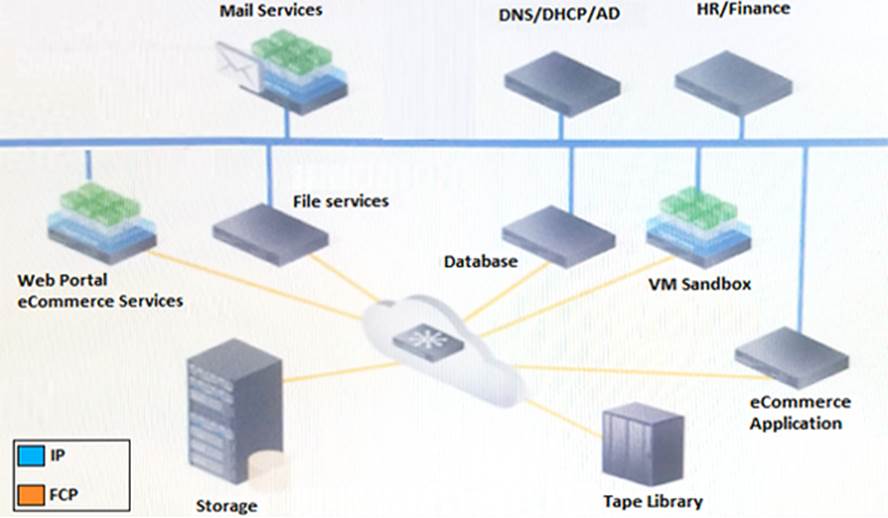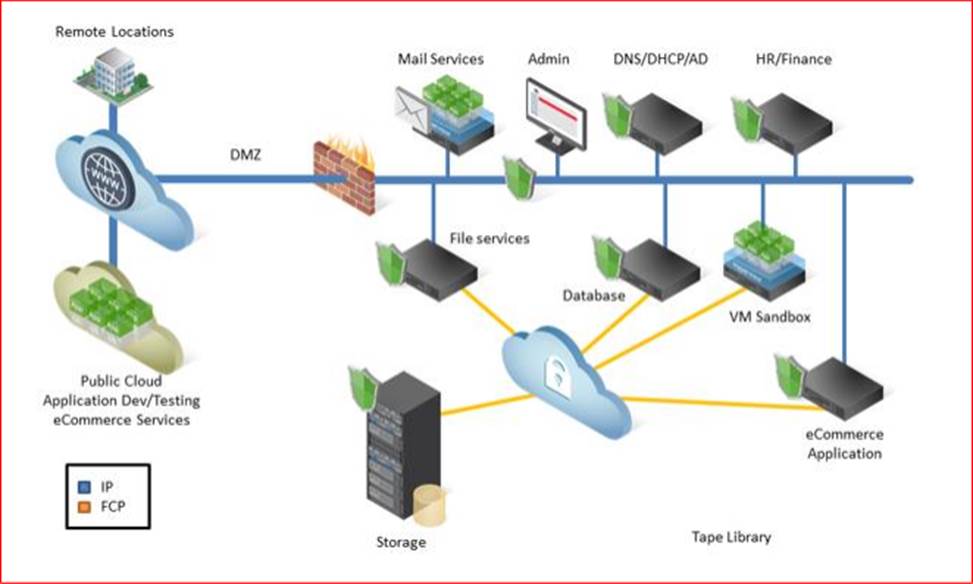Practice Free D-CI-DS-23 Exam Online Questions
A cloud architect is designing a hybrid cloud for an organization. A requirement for this environment is for federated access to both cloud provisioning APIs.
What must be configured between both cloud providers’ authentication mechanisms?
- A . Shared super-user account
- B . Trust relationship
- C . Identical accounts
- D . IPsec VPN
Refer to the exhibit.

Your company is currently using a traditional SAN storage network. The server infrastructure is partially virtualized. There is a public cloud in place that is used to test development and application migration to cloud.
Business requirements:
– Consolidate the network, storage, and compute resources
– Simplify network management and storage provisioning
– Maintain application performance
– Need to share resources to reduce cost and improve efficiency
Other considerations:
– Monitoring of protection SLAs
– All transactions must be logged for auditing review
– Users are validated using internal credentials
Refer to Case 4.
You must design the solution to enable external access to the eCommerce application using a Public cloud. The development team wants to ensure that the application has a known performance profile.
Which consideration offers best practices to address this concern?
- A . Automation Management
- B . Multicloud Compliance
- C . Interoperability
- D . Physical Server Consistency
What does CI stand for in the context of cloud infrastructure?
- A . Central Integration
- B . Converged Infrastructure
- C . Cloud Integration
- D . Continuous Improvement
Refer to the exhibit.

Your company recently negotiated several contracts with new customers to use its proprietary eCommerce system. As a result, the scalability of the eCommerce system data is a concern for the Marketing and Sales departments.
Business requirements:
– Application resources must be able to scale up and down quickly
– External customers have protected access to the eCommerce application
– Metrics and reporting to track the use of resources and data
Other considerations:
– Applications are provided through the public cloud
– Address security vulnerabilities for customer data in the cloud
Refer to Case 3.
You are tasked with designing a cloud. You review the existing infrastructure and business requirements. You select a Do-It-Yourself solution to expand the existing Platform 2.0 infrastructure.
Before presenting this solution to the company, you must calculate the 3-year TCO using the following criteria:
– Hardware and software maintenance = $ 35,000
– Orchestration software licensing = $ 25,000
– Storage = $ 6,000 (6 TB @ $ 1/GB)
What is the correct TCO value?
- A . $ 66,000
- B . $116,000
- C . $128,000
- D . $198,000
Which of the following are common methods for collecting data in a cloud environment?
(Select all that apply)
- A . Manual data entry
- B . Automated monitoring and logging
- C . Sending data by post
- D . Real-time streaming data
As a cloud architect you are working with an organization to choose between a DIY or packaged PaaS Solution.
What is a selection criterion that applies to DIY?
- A . Has a higher cost of licensing and support
- B . Is a more stable platform
- C . Has built-in governance policies
- D . Supports automated configuration
You are creating a cloud infrastructure design for an organization. The cloud design includes physical servers with hypervisors which will be used to host consumer services. The hosts are managed through a hypervisor element manager.
Which step should be taken to secure the hypervisor environment?
- A . Place the element manager administrative interfaces on a consumer-facing network and hypervisor administrative interfaces on an isolated network
- B . Place the element manager administrative interfaces on a consumer-facing network and hypervisor administrative interfaces on a secure network
- C . Place the element manager and hypervisor administrative interfaces on a secure network
- D . Place the element manager and hypervisor administrative interfaces on a consumer- facing network
Which properties define a cloud environment?
- A . Power, connectivity, physical security
- B . Self-service, dedicated leased services in-house
- C . Dedicated, but privatized, virtualized data center technologies in-house
- D . Self-service, Internet server computing, shared resources, pay as you use
Which services are typically offered by cloud service providers?
- A . Operating environment, virtualization, applications
- B . Bundled storage, applications, operating systems
- C . Software, platform, infrastructure
- D . Compute, storage, connectivity
What is a key consideration when designing a Do-It-Yourself (DIY) PaaS solution?
- A . High level of vendor lock-in
- B . Limited customization options
- C . Outsourcing all application development tasks
- D . Full control and flexibility over the platform
